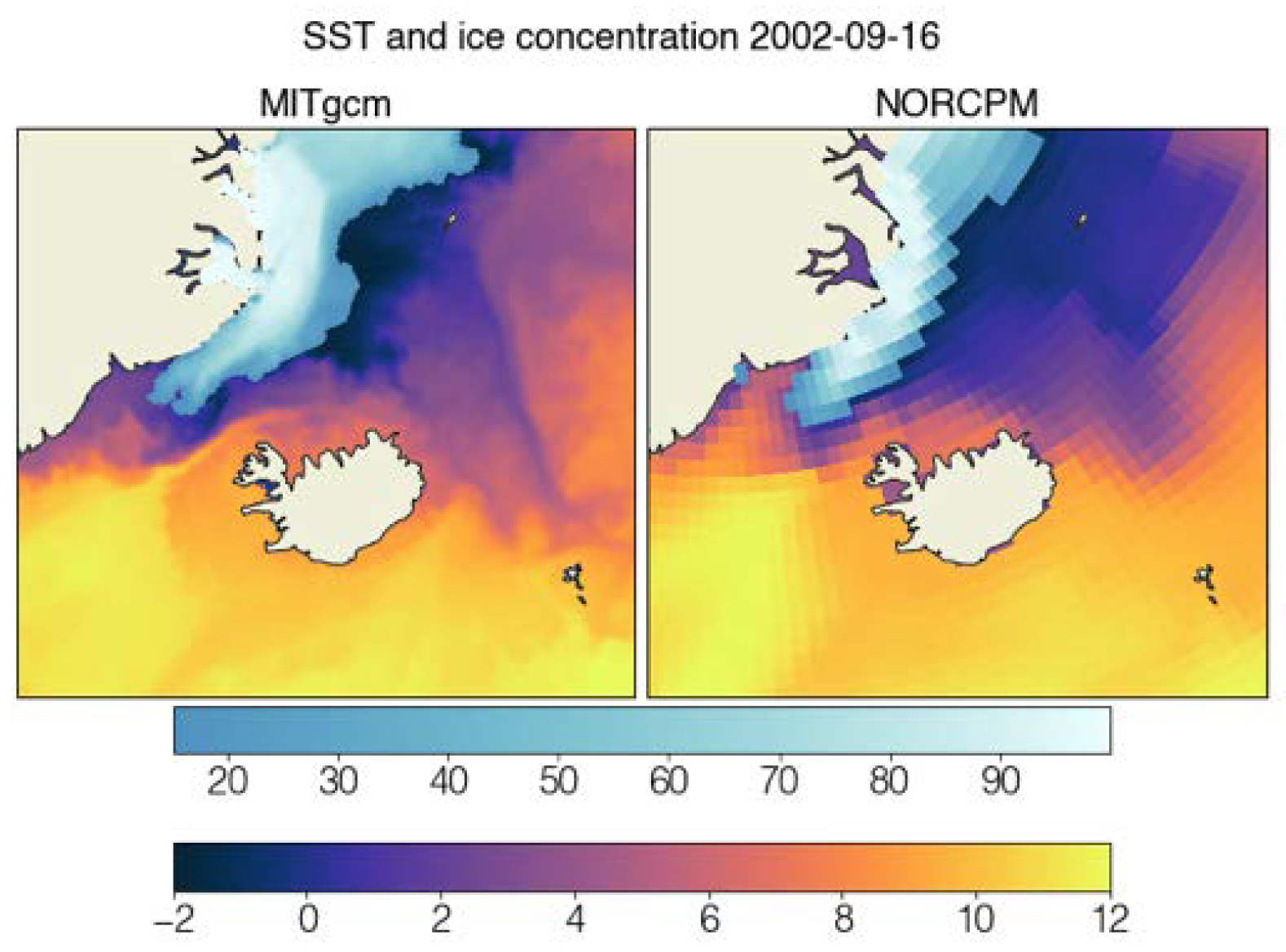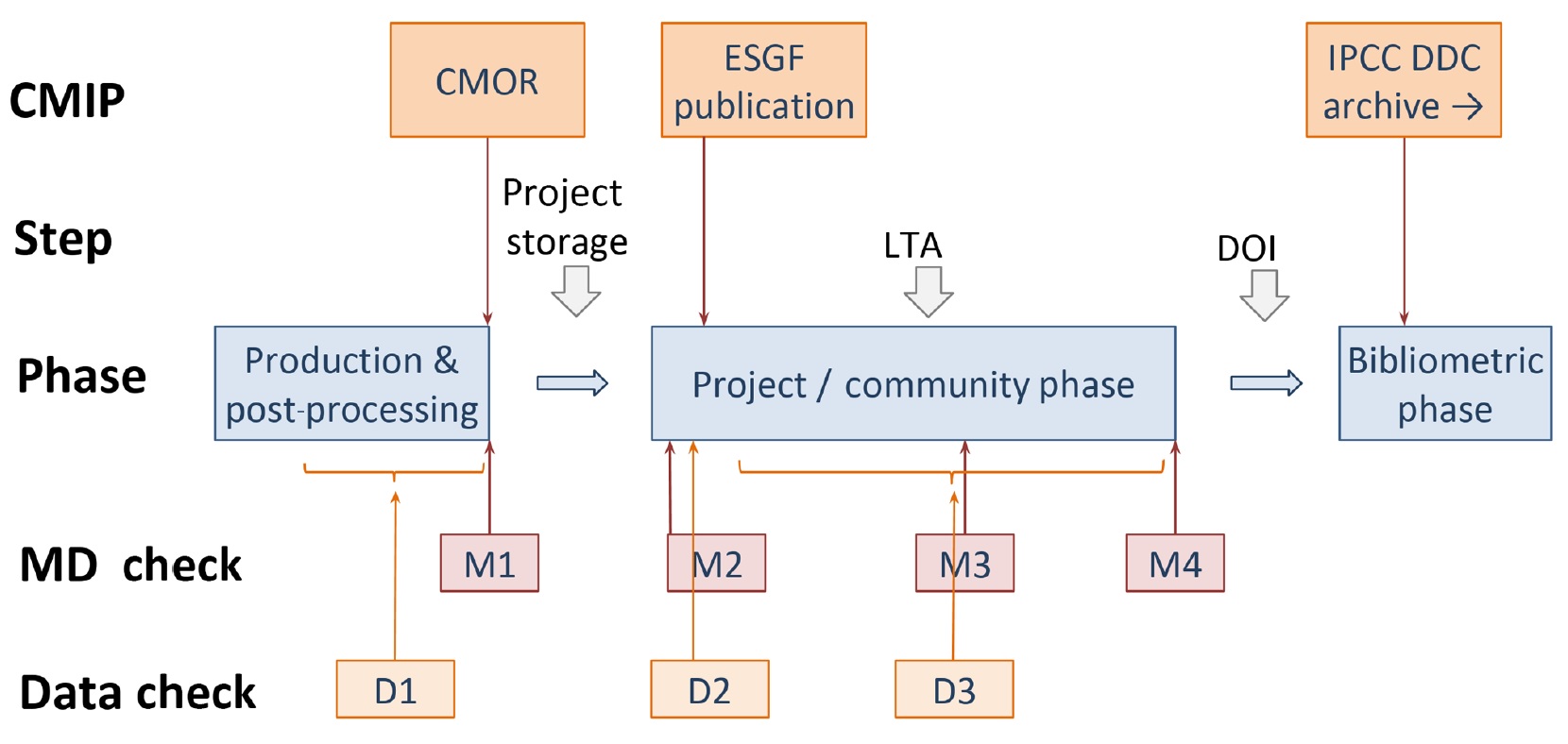Tools
The following tools are used in the ARCPATH project. The tools are listed in alphabetical order.
ARCPATH Tool
ARCPATH has developed a climate prediction tool using state-of-the-art data assimilation techniques to combine contemporary observations of the climate with latest Earth System Models. Project partners have developed global climate predictions using two Earth System Models: the Norwegian Climate Prediction Model (NorCPM), and the Earth System Model for the Climate (EC-Earth3). In addition, a regional climate model has been used to downscale the predictions to be useful for climate adaptation in the targeted areas. This regional model employed d a high-resolution ocean model and a high-resolution atmosphere model over the target region of ARCPATH for the downscaling. The concepts of the ARCPATH Tool are presented in depth in (Yang et al., 2020).

Figure 1. Sea surface temperature in the high-resolution model, MITgcm (left), and the coarse model, NorCPM (right) .
Links to software and documentation:
- ARCPATH website: https://ncoe-arcpath.org/
References
NordForsk, 2021. New tool can predict short-term climate changes. https://www.nordforsk.org/news/new-tool-can-predict-short-term-climate-changes
Yang S, Gao Y, Koenigk T, Keenlyside N, Counillon F., 2020. The Climate Model: An ARCPATH Tool to Understand and Predict Climate Change. In: Nordic Perspectives on the Responsible Development of the Arctic: Pathways to Action. Book chapter in “Nordic Perspectives on the Responsible Development of the Arctic: Pathways to Action”, Springer International Publishing, 2020. https://www.springerprofessional.de/en/nordic-perspectives-on-the-responsible-development-of-the-arctic/18539692
Climate Model Output Rewriter (CMOR)
The Climate Model Output Rewriter (CMOR) is a library that can be used to generate CF-compliant netCDF files. The library is developed to ensure the produced netCDF files following requirements for standard modelling experiments defined by climate community. Such an experiment is referred to as a Model Intercomparison Project (MIP). Two of the best projects include the Coupled Model Intercomparison Project (CMIP) created to improve knowledge of climate change, and the Atmospheric Model Intercomparison Project (AMIP) for global coupled ocean-atmosphere general circulation models (GCMs).
CMOR is written in C, but in addition offers bindings to Python and FORTRAN 90, making the library more versatile. The netCDF files generated by CMOR is “self-describing” with standard metadata elements to document the data, making it easier to compare results from different climate models.

Figure 2. Schematic of the phases of quality assurance, displaying earlier stages in the hands of modelling centres (left), and more formal long-term data curation stages (right). Quality assurance is applied both to the data (D, above) as well as the metadata (M) describing the data. Figure drawn from the WIP’s Quality Assurance position paper. (Venkatramani et al., 2018).
Links to software and documentation:
- CMOR website: https://pcmdi.github.io/cmor-site/
- CMOR users guide: https://pcmdi.github.io/cmor-site/media/pdf/cmor_users_guide.pdf
- Package: libcmor2 (3.6.1-1): https://packages.debian.org/stable/libs/libcmor2
References:
Taylor, Karl E., Doutriaux, Charles, and Jean-Yves Peterschmitt, 2006. Climate Model Output Rewriter (CMOR).
Venkatramani Balaji, Karl E. Taylor, Martin Juckes, Bryan N. Lawrence, Paul J. Durack, Michael Lautenschlager, Chris Blanton, Luca Cinquini, Sébastien Denvil, Mark Elkington, Francesca Guglielmo, Eric Guilyardi, David Hassell, Slava Kharin, Stefan Kindermann, Sergey Nikonov, Aparna Radhakrishnan, Martina Stockhause, Tobias Weigel, and Dean Williams, 2018. Requirements for a global data infrastructure in support of CMIP6, … https://doi.org/10.5194/gmd-11-3659-2018
NorESM Diagnostic Tool
The NorESM Diagnostic Tool is a package made for evaluating the performance of the NorESM model. The tool is comprised of a set of scripts and command utilities (e.g. bash/cshrc, NCO, CDO, NCL) to provide a general evaluation and quick preview of the model performance with a single command. This tool package works on the original model output and has NorESM-specific diagnostics.
The tool has several components:
- CAM_DIAG: (Based on NCAR’s AMWG Diagnostics Package)
- CLM_DIAG: (Based on CLM Land Model Diagnostics Package)
- CICE_DIAG: snow/sea ice volume/area
- HAMOCC_DIAG: time series, climaotology, zonal mean, regional mean
- BLOM_DIAG: time series, climatologies, zonal mean, fluxes, etc

Figure 3. Code structure (NorESM Diagnostic Tool tutorial).
Links to software and documentation:
- NorESM Diagnostic Tool: https://noresm-docs.readthedocs.io/en/noresm1/modeldiagnostics.html
- Tutorials: https://nordicesmhub.github.io/noresmdiagnostics/03-noresmdiagnostic/
- Code: https://github.com/NordicESMhub/noresmdiagnostics
ESMValTool
The Earth System Model Evaluation Tool (ESMValTool) aims at improving diagnosing and understanding of the causes and effects of model biases and inter-model spread. ESMValTool is an open source community development effort enabling users and developers alike to exchange diagnostic source code and evaluation results from the Coupled Model Intercomparison Project (CMIP) ensemble. This will advance ESM evaluation and thereby support both activities within CMIP at program level and at individual modelling centres.
ESMValTool is developed as aa benchmarking and evaluation tool for rapidly generating well documented analyses whenever model output from CMIP simulations becomes available, e.g., through one of the ESGF data nodes. The tool applied standard recipes that reproduce a certain set of diagnostics and performance metrics, as described in e.g. Chapter 9 of the Intergovernmental Panel on Climate Change (IPCC) Fifth Assessment Report (AR5) (Flato et al., 2013). This is expected to establish a routinely and systematic way of evaluating model results in an efficient manner, letting scientists focus on developing more innovative methods of analysis rather than repeatedly reinventing the wheel for model evalation.

Figure 4. Schematic of the ESMValTool system architecture (Weigel et al., 2021).
Links to software and documentation:
- ESMValTool website: https://www.esmvaltool.org/
- Code for ESMValTool v2.2.0: https://doi.org/10.5281/zenodo.4562215
- Code for ESMValCore package: https://doi.org/10.5281/zenodo.4525749
References
Andela, Bouwe, Broetz, Bjoern, de Mora, Lee, Drost, Niels, Eyring, Veronika, Koldunov, Nikolay, Lauer, Axel, Mueller, Benjamin, Predoi, Valeriu, Righi, Mattia, Schlund, Manuel, Vegas-Regidor, Javier, Zimmermann, Klaus, Adeniyi, Kemisola, Arnone, Enrico, Bellprat, Omar, Berg, Peter, Bock, Lisa, Caron, Louis-Philippe, … Weigel, Katja. (2021). ESMValTool (v2.2.0). Zenodo. https://doi.org/10.5281/zenodo.4562215
Flato, G., J. Marotzke, B. Abiodun, P. Braconnot, S.C. Chou, W. Collins, P. Cox, F. Driouech, S. Emori, V. Eyring, C. Forest, P. Gleckler, E. Guilyardi, C. Jakob, V. Kattsov, C. Reason, and M. Rummukainen, 2013: Evaluation of climate models. In Climate Change 2013: The Physical Science Basis. Contribution of Working Group I to the Fifth Assessment Report of the Intergovernmental Panel on Climate Change. T.F. Stocker, D. Qin, G.-K. Plattner, M. Tignor, S.K. Allen, J. Doschung, A. Nauels, Y. Xia, V. Bex, and P.M. Midgley, Eds. Cambridge University Press, pp. 741-882, doi:10.1017/CBO9781107415324.020.
Weigel, K., Bock, L., Gier, B. K., Lauer, A., Righi, M., Schlund, M., Adeniyi, K., Andela, B., Arnone, E., Berg, P., Caron, L.-P., Cionni, I., Corti, S., Drost, N., Hunter, A., Lledó, L., Mohr, C. W., Paçal, A., Pérez-Zanón, N., Predoi, V., Sandstad, M., Sillmann, J., Sterl, A., Vegas-Regidor, J., von Hardenberg, J., and Eyring, V.: Earth System Model Evaluation Tool (ESMValTool) v2.0 – diagnostics for extreme events, regional and impact evaluation, and analysis of Earth system models in CMIP, Geosci. Model Dev., 14, 3159–3184, https://doi.org/10.5194/gmd-14-3159-2021, 2021.
